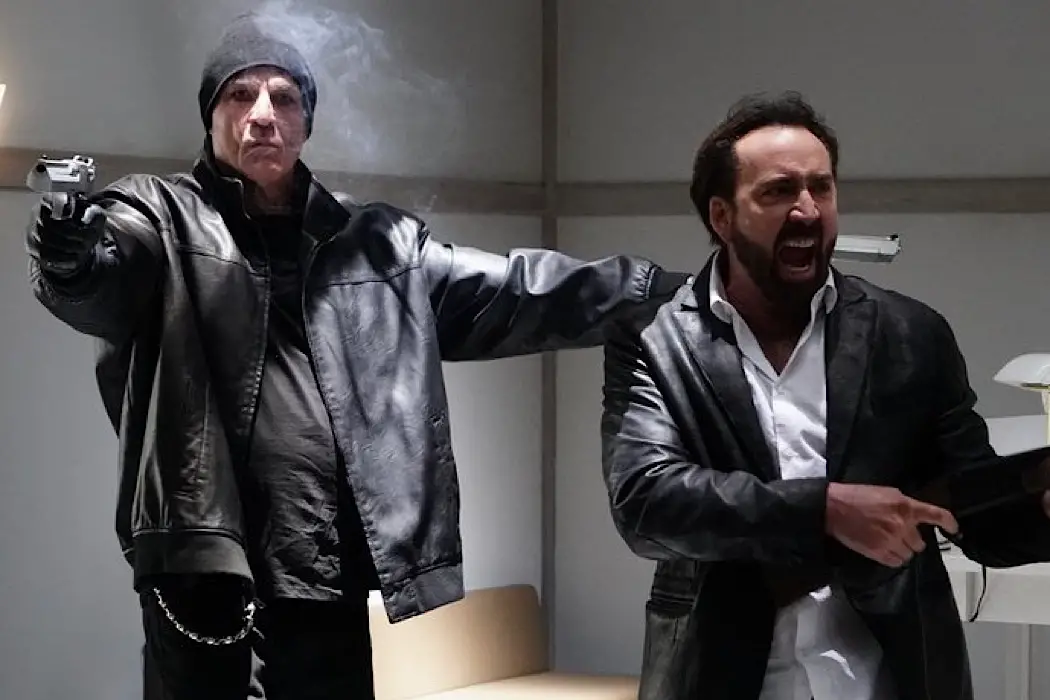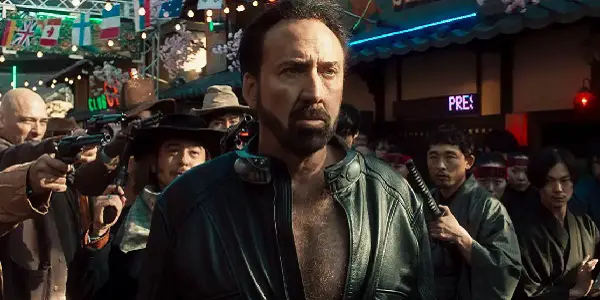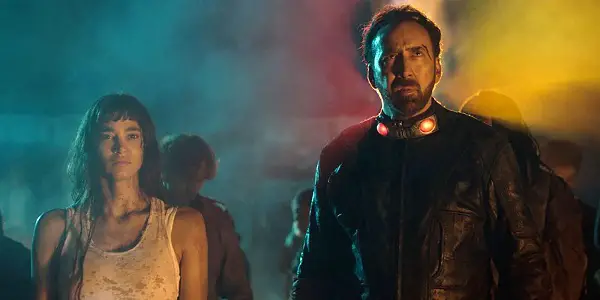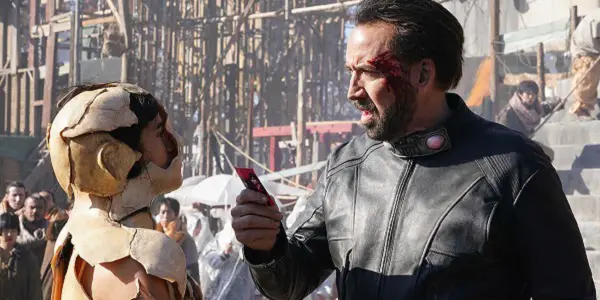PRISONERS OF THE GHOSTLAND: Balls to the Wall

Lee Jutton has directed short films starring a killer toaster,…
You know the film you’re about to watch is going to be a special one when the star is quoted on the poster saying it is the wildest movie they’ve ever made. But when that star is none other than Nicolas Cage, he of the wildly uneven but extremely entertaining career that includes such memorable films as Raising Arizona, Wild at Heart, Leaving Las Vegas, Mandy, and countless others, you’d be forgiven for raising your eyebrows. After all, could this really be the wildest thing Cage has ever done? The guy stole the Declaration of Independence, for goodness sakes! Yet in Japanese director Sion Sono (Love Exposure, Red Post on Escher Street), Cage may have finally met his match in manic moviemaking heaven.
Prisoners of the Ghostland, Sono’s English-language debut, stars Cage as an infamous criminal who is told to track down the adopted granddaughter of the warlord who rules the Old West-meets-Mad Max town in which the film takes place. Sono takes a hefty pile of mismatched genres, throws them all in a blender, and cranks the speed up to an explosive eleven, with Cage as the leather-clad center of the madness swirling around him. Those familiar with both men’s idiosyncratic oeuvres—and with a particular fondness for their work at its most outlandishly unconventional—will adore Prisoners of the Ghostland. It may be a bit too much for others with less adventurous cinematic palates, but if that’s you, I’m not sure why you’re watching a Sion Sono film in the first place.
Dead Man Walking
The film’s visually striking opening sets the tone for what is to follow, with a bank robbery that goes awry. As gunfire explodes, the shiny white walls of the bank are splattered with dark blood. A gumball machine is smashed by oncoming bullets, the colorful candies bouncing around the bank and into the street in cheerful mockery of the death and destruction taking place inside.
Later, one of the robbers, Hero (Cage), is still haunted by the gruesome events of that day as he languishes in the custody of the local authorities. However, he’s given an unusual chance for redemption in the form of an assignment from the notorious Governor (Bill Moseley), whose crisp white suit belies the blood that is regularly shed in his name courtesy of his loyal servant, Yasujiro (Tak Sakaguchi). The Governor’s adopted granddaughter, Bernice (Sofia Boutella) has disappeared, and Hero is being sent to bring her back. That Bernice may have left—nay, even escaped—on her own accord is beside the point when it comes to the Governor, a man whose town’s streets are lined with barred windows filled with captive women waiting to be purchased.

To keep Hero focused on his quest, he’s outfitted in a leather suit with some carefully placed explosives; if Hero doesn’t find and return Bernice unharmed before five days expire, the suit will explode. (It’s worth noting that two of the explosives are placed on his crotch, the idea being that if he gets too turned on and thinks about violating Bernice, his testicles will be kaput.) Pretty solid motivation to stick to the task at hand, eh?
Alas, in order to find Bernice, Hero will have to venture into a supernatural waste known as the Ghostland. In order to escape, he’ll have to help the residents of the Ghostland break the terrible spell that lies over the land. And once he does, the question remains: how can he possibly return Bernice to such an evil man as the Governor with his already battered conscience intact?
Sound and Fury
From neo-noir to Western, samurai drama to post-apocalyptic thriller, Prisoners of the Ghostland wears its influences prominently on its explosive leather sleeve. The vibrant town in which much of the film takes place looks like a frontier set picked up out of an old Hollywood studio backlot and dropped into 18th century Japan, while the Ghostland resembles the industrial wasteland ruled over by Immortan Joe in Mad Max: Fury Road with its crumbling architecture and lethally dangerous landscape.

There is not a single frame in Prisoners of the Ghostland that doesn’t have something striking to catch the eye; in fact, most are overflowing with visual excess, courtesy of production designer Toshihiro Isomi. In one of the film’s more deliciously weird visual touches, people who accidentally find their way into the Ghostland are transformed into human mannequins, with ragged pieces of synthetic faces pasted over their own, turning them into some strange sort of low-rent cyborgs. There are a few odd musical sequences that get all of the characters in a given scene involved and may have you wondering if you’re losing your mind in real-time but in a good way. And the action scenes, many of which are centered around martial arts master Sakaguchi’s Yasujiro and his swirling sword, are a great deal of gloriously gory fun.
The film’s costumes, created by Chieko Matsumoto, range from traditional Japanese garb to old-timey sheriff gear to avant-garde ensembles that could have come straight from a designer showroom or a dumpster. (Which begs the question: why do the scrounged-up outfits worn by characters in post-apocalyptic movies always end up looking so cool? I wouldn’t have the energy for it if I were them.) Indeed, many characters appear and act as though they are in an entirely different film than the others they are sharing a given scene with. It’s all so gloriously over the top that it’s impossible to tear your eyes from the screen even as the plot predictably goes careening off the rails.

Amidst all the chaos, Cage is actually a somewhat calming presence, especially when compared with Moseley’s camp-tastic portrayal of the Governor and Nick Cassevetes’ appropriately named Psycho; I’m not sure there’s another actor who could face the prospect of having one of his testicles blown off with more natural gravitas. The same goes for Boutella, whose Bernice is equal parts damsel in distress and stoic heroine of her own story; like Cage, she has an eccentric enough filmography under her belt to seem perfectly at home in Sono’s wild, weird world. The two of them, surrounded by a delightfully diverse cast of supporting characters who gleefully embrace any opportunity to chew the scenery to pieces, lend a strange believability to their characters that helps ground Prisoners of the Ghostland…well, not exactly in reality, but at least in something the viewer can be invested in.
Conclusion
It’s definitely not for everyone, but I’ll take Prisoners of the Ghostland’s cavalcade of cinematic insanity over a paint-by-numbers blockbuster designed to appeal to the lowest common denominator any day of the week. If you’re unfamiliar with the previous work of Sion Sono, Cage and company are as good of guides as any to introduce you to his singular oeuvre.
What do you think? Are you familiar with the films of Sion Sono? Share your thoughts in the comments below.
Prisoners of the Ghostland is released in the U.S. on September 17, 2021. You can find more international release dates here.
Watch Prisoners of the Ghostland
Does content like this matter to you?
Become a Member and support film journalism. Unlock access to all of Film Inquiry`s great articles. Join a community of like-minded readers who are passionate about cinema - get access to our private members Network, give back to independent filmmakers, and more.
Lee Jutton has directed short films starring a killer toaster, a killer Christmas tree, and a not-killer leopard. Her writing has appeared in publications such as Film School Rejects, Bitch: A Feminist Response to Pop Culture, Bitch Flicks, TV Fanatic, and Just Press Play. When not watching, making, or writing about films, she can usually be found on Twitter obsessing over soccer, BTS, and her cat.













